Abstract
Potassium homoeostasis in the heart was studied during atrial pacing in 20 patients undergoing diagnostic coronary angiography. The potassium concentrations in the coronary sinus and a systemic artery were recorded continuously by means of catheter tip potassium electrodes. Ten patients with coronary artery disease and a positive exercise test developed chest pain and ST segment depression on the electrocardiogram during atrial pacing. Potassium concentrations in the coronary sinus rose initially and increased further when myocardial ischaemia developed. Ten patients including five with normal coronary arteries remained symptom free during atrial pacing with no electrocardiographic changes. In these patients coronary sinus potassium concentration increased at the onset of pacing, but returned to near control values despite continued pacing. In both groups arterial potassium concentration remained constant. Immediately after the end of pacing there was an abrupt transient fall in potassium concentrations in the coronary sinus to below control values. These results indicate that in man, as in other species, an increase in heart rate causes the transient movement of potassium out of the cell into the extracellular space. The onset of myocardial ischaemia is associated with a further loss of potassium from the cell. The end of pacing or ischaemia is accompanied by a re-uptake of potassium by heart muscle.
Full text
PDF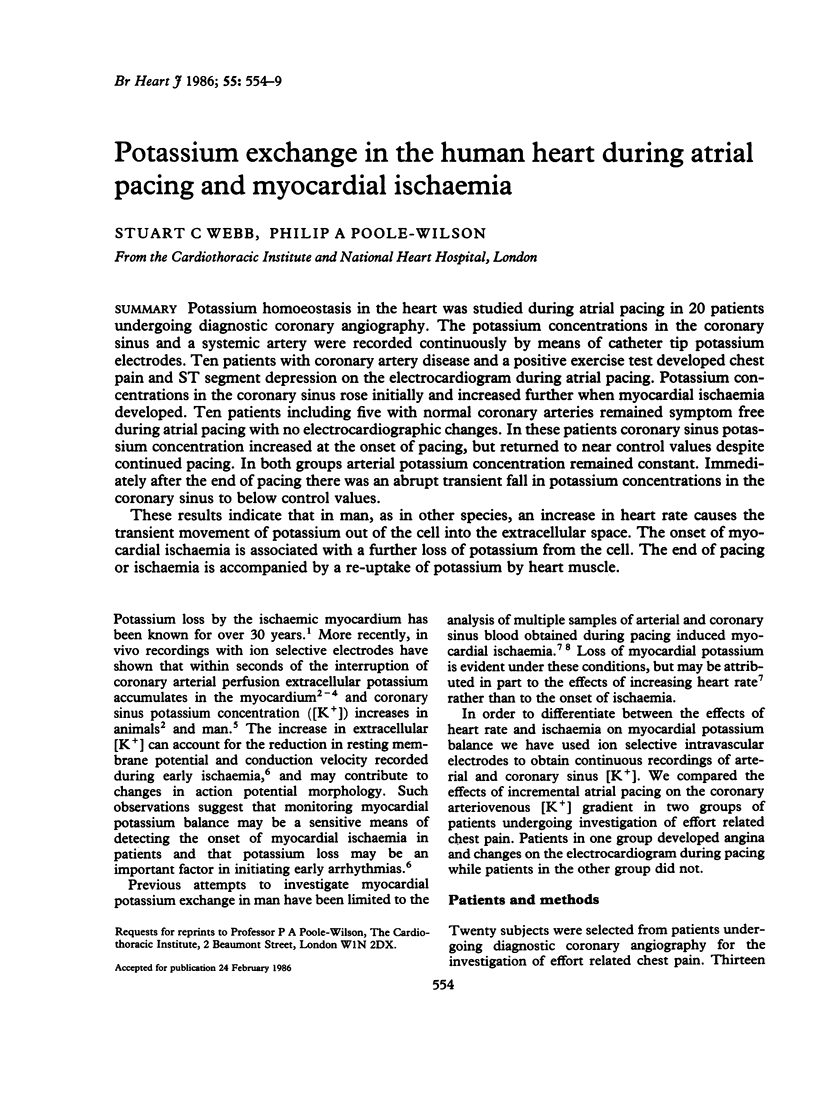
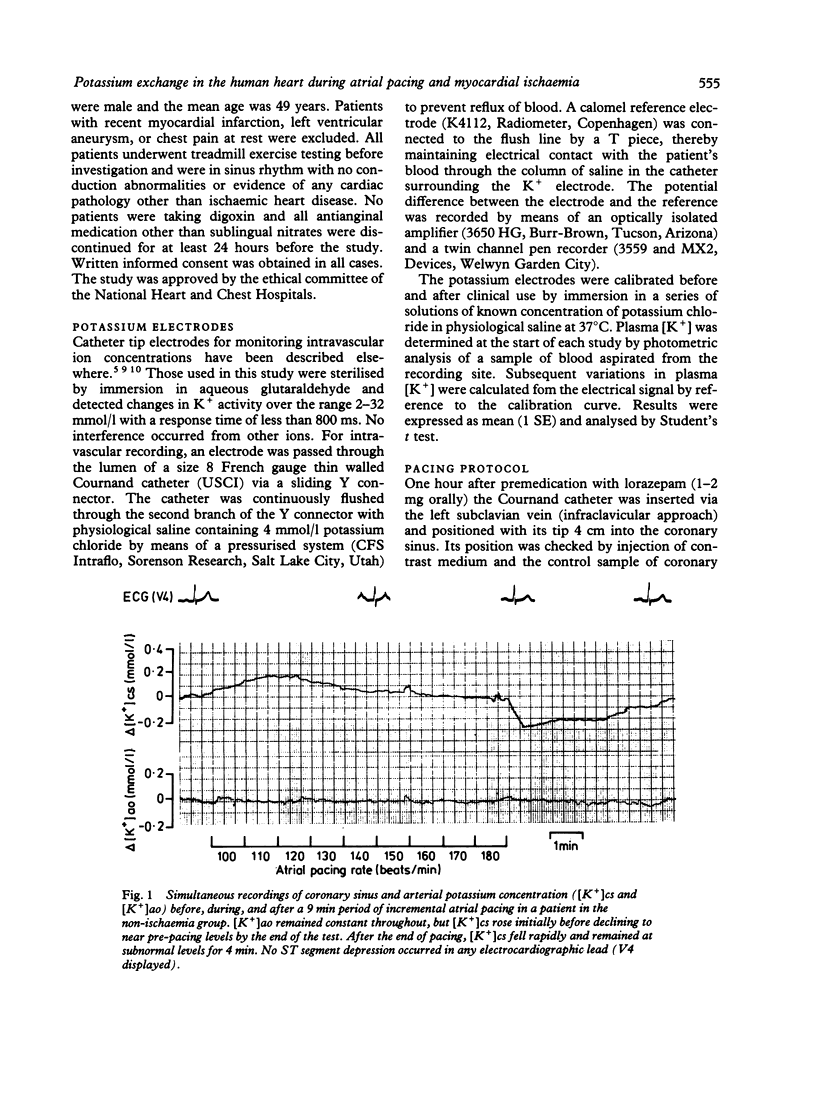
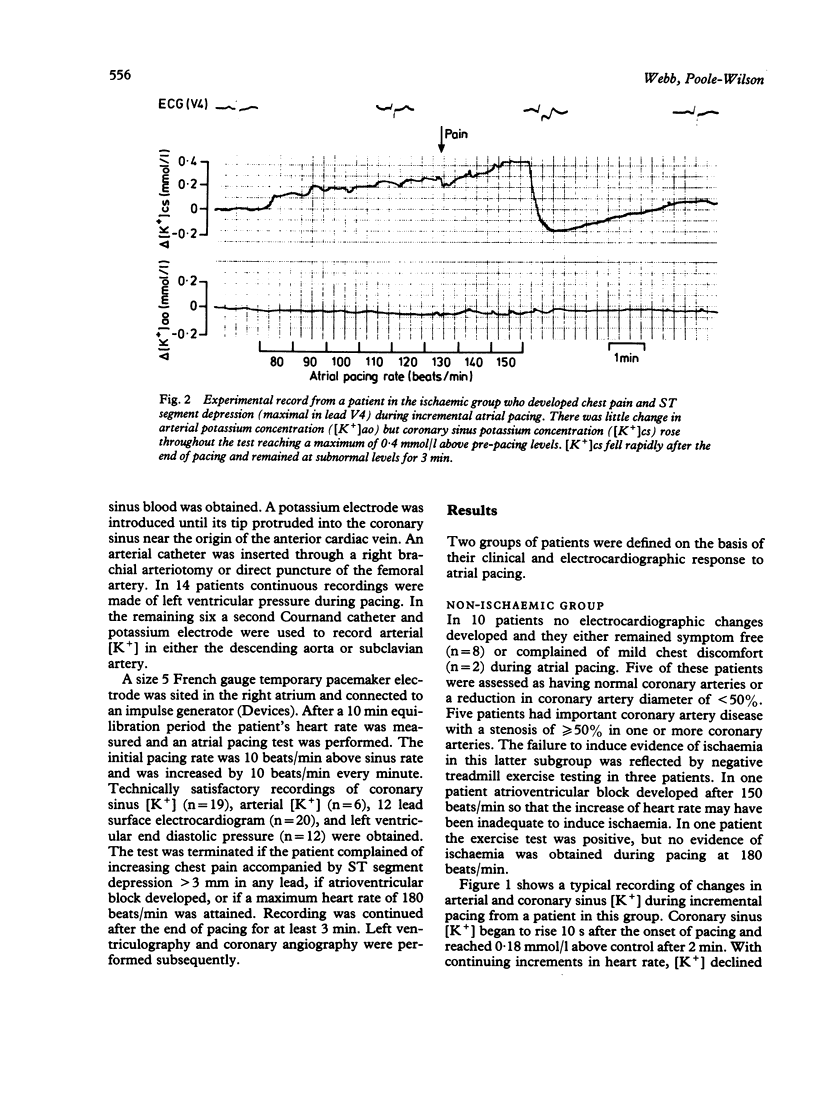

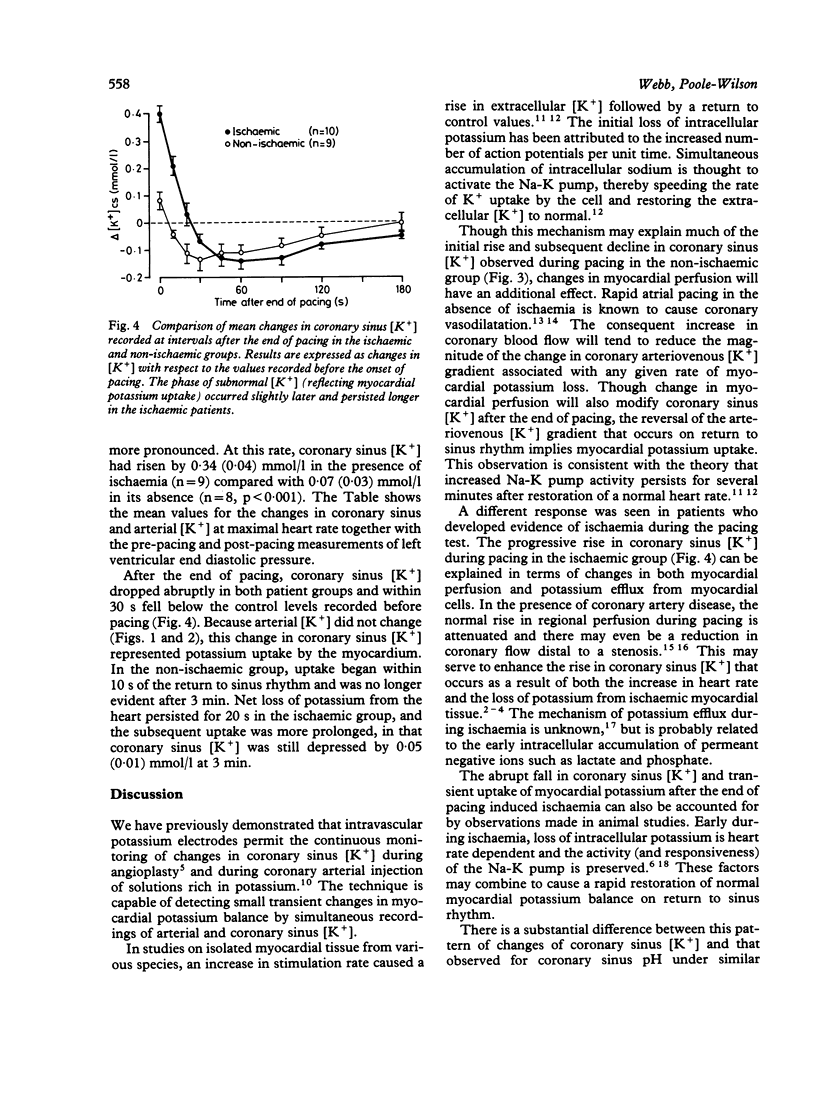
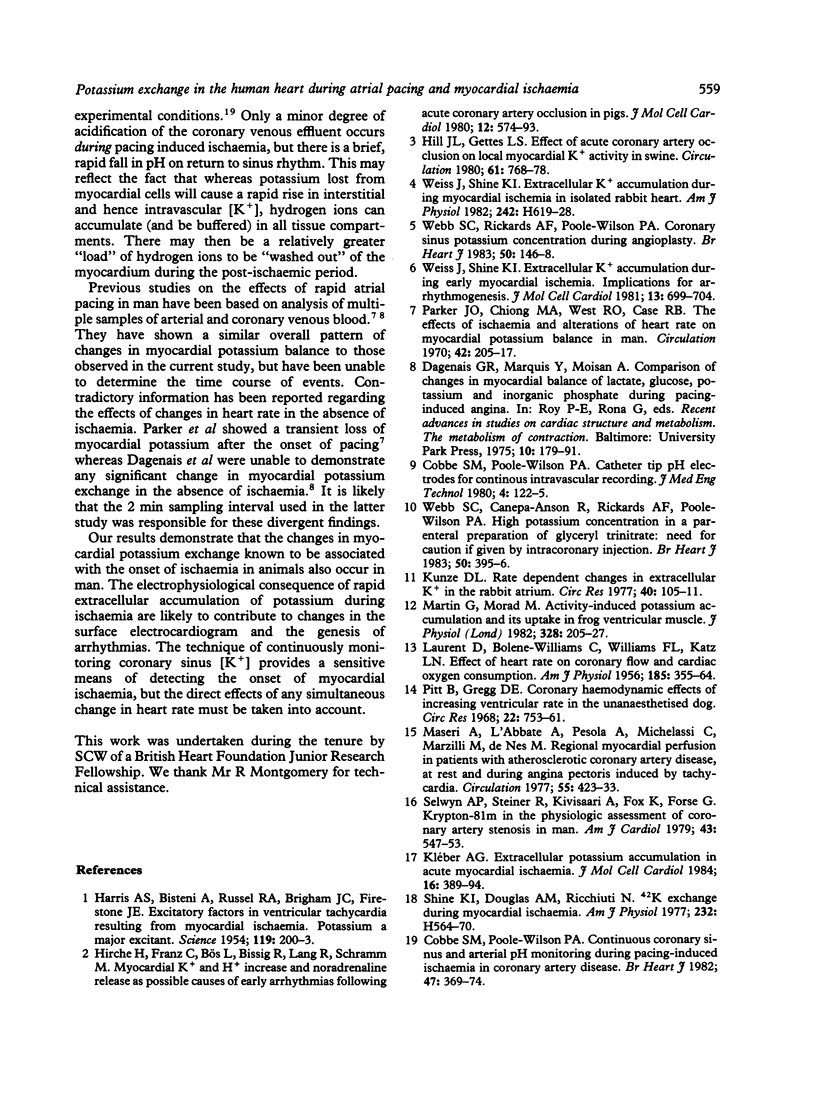
Selected References
These references are in PubMed. This may not be the complete list of references from this article.
- Cobbe S. M., Poole-Wilson P. A. Catheter tip pH electrodes for continuous intravascular recording. J Med Eng Technol. 1980 May;4(3):122–124. doi: 10.3109/03091908009161104. [DOI] [PubMed] [Google Scholar]
- Cobbe S. M., Poole-Wilson P. A. Continuous coronary sinus and arterial pH monitoring during pacing-induced ischaemia in coronary artery disease. Br Heart J. 1982 Apr;47(4):369–374. doi: 10.1136/hrt.47.4.369. [DOI] [PMC free article] [PubMed] [Google Scholar]
- Dagenais G. R., Marquis Y., Moisan A. Comparison of changes in myocardial balances of lactate, glucose potassium, and inorganic phosphate during pacing-induced angina. Recent Adv Stud Cardiac Struct Metab. 1975;10:179–191. [PubMed] [Google Scholar]
- HARRIS A. S., BISTENI A., RUSSELL R. A., BRIGHAM J. C., FIRESTONE J. E. Excitatory factors in ventricular tachycardia resulting from myocardial ischemia; potassium a major excitant. Science. 1954 Feb 12;119(3085):200–203. doi: 10.1126/science.119.3085.200. [DOI] [PubMed] [Google Scholar]
- Hill J. L., Gettes L. S. Effect of acute coronary artery occlusion on local myocardial extracellular K+ activity in swine. Circulation. 1980 Apr;61(4):768–778. doi: 10.1161/01.cir.61.4.768. [DOI] [PubMed] [Google Scholar]
- Katzung B. G., Morgenstern J. A. Effects of extracellular potassium on ventricular automaticity and evidence for a pacemaker current in mammalian ventricular myocardium. Circ Res. 1977 Jan;40(1):105–111. doi: 10.1161/01.res.40.1.105. [DOI] [PubMed] [Google Scholar]
- Kléber A. G. Extracellular potassium accumulation in acute myocardial ischemia. J Mol Cell Cardiol. 1984 May;16(5):389–394. doi: 10.1016/s0022-2828(84)80610-0. [DOI] [PubMed] [Google Scholar]
- LAURENT D., BOLENE-WILLIAMS C., WILLIAMS F. L., KATZ L. N. Effects of heart rate on coronary flow and cardiac oxygen consumption. Am J Physiol. 1956 May;185(2):355–364. doi: 10.1152/ajplegacy.1956.185.2.355. [DOI] [PubMed] [Google Scholar]
- Martin G., Morad M. Activity-induced potassium accumulation and its uptake in frog ventricular muscle. J Physiol. 1982 Jul;328:205–227. doi: 10.1113/jphysiol.1982.sp014260. [DOI] [PMC free article] [PubMed] [Google Scholar]
- Maseri A., L'Abbate A., Pesola A., Michelassi C., Marzilli M., De Nes M. Regional myocardial perfusion in patients with atherosclerotic coronary artery disease, at rest and during angina pectoris induced by tachycardia. Circulation. 1977 Mar;55(3):423–433. doi: 10.1161/01.cir.55.3.423. [DOI] [PubMed] [Google Scholar]
- Parker J. O., Chiong M. A., West R. O., Case R. B. The effect of ischemia and alterations of heart rate on myocardial potassium balance in man. Circulation. 1970 Aug;42(2):205–217. doi: 10.1161/01.cir.42.2.205. [DOI] [PubMed] [Google Scholar]
- Pitt B., Gregg D. E. Coronary hemodynamic effects of increasing ventricular rate in the unanesthetized dog. Circ Res. 1968 Jun;22(6):753–761. doi: 10.1161/01.res.22.6.753. [DOI] [PubMed] [Google Scholar]
- Selwyn A. P., Steiner R., Kivisaari A., Fox K., Forse G. Krypton-81m in the physiologic assessment of coronary arterial stenosis in man. Am J Cardiol. 1979 Mar;43(3):547–553. doi: 10.1016/0002-9149(79)90012-2. [DOI] [PubMed] [Google Scholar]
- Shine K. I., Douglas A. M., Ricchiuti N. 42K exchange during myocardial ischemia. Am J Physiol. 1977 Jun;232(6):H564–H570. doi: 10.1152/ajpheart.1977.232.6.H564. [DOI] [PubMed] [Google Scholar]
- Webb S. C., Canepa-Anson R., Rickards A. F., Poole-Wilson P. A. High potassium concentration in a parenteral preparation of glyceryl trinitrate. Need for caution if given by intracoronary injection. Br Heart J. 1983 Oct;50(4):395–396. doi: 10.1136/hrt.50.4.395. [DOI] [PMC free article] [PubMed] [Google Scholar]
- Webb S. C., Rickards A. F., Poole-Wilson P. A. Coronary sinus potassium concentration recorded during coronary angioplasty. Br Heart J. 1983 Aug;50(2):146–148. doi: 10.1136/hrt.50.2.146. [DOI] [PMC free article] [PubMed] [Google Scholar]
- Weiss J., Shine K. I. Extracellular K+ accumulation during myocardial ischemia in isolated rabbit heart. Am J Physiol. 1982 Apr;242(4):H619–H628. doi: 10.1152/ajpheart.1982.242.4.H619. [DOI] [PubMed] [Google Scholar]
- Weiss J., Shine K. I. Extracellular potassium accumulation during myocardial ischemia: implications for arrhythmogenesis. J Mol Cell Cardiol. 1981 Jul;13(7):699–704. doi: 10.1016/0022-2828(81)90277-7. [DOI] [PubMed] [Google Scholar]


